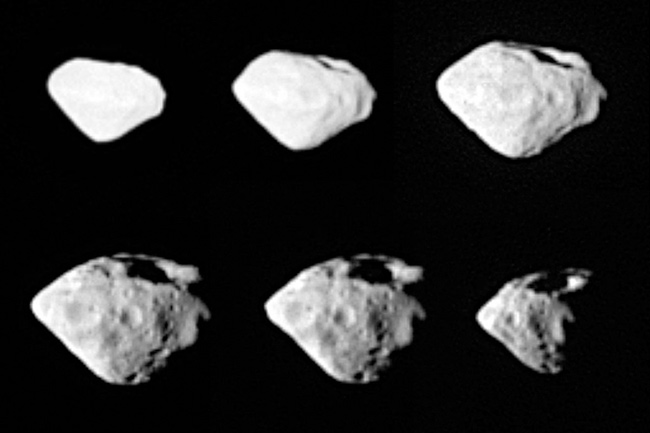Despite Glitch, European Spacecraft's Asteroid Flyby a Success

PARIS - Europe'sRosetta comet-chaser satellite successfully detoured to take a look at a raretype of asteroid Friday, getting a close-up view of the diamond-shaped Steinsasteroid, a gray, 3-mile (5-km) wide rock that appears in images as apock-marked with multiple craters that ultimately will help determine its age.
TheEuropean Space Agency (ESA) probe?s narrow-angle camera apparently switched offas it closed in on the asteroid Steins, but the photo survey was ultimately ?asideline? mission tothe actual flyby and another camera worked perfectly, ESA officials said ina post-flyby briefing early Saturday at the agency?s ESOC space operationscenter in Darmstadt, Germany.
"Wewere very conservative, perhaps too conservative," said Uwe Keller,principal investigator for Rosetta's OSIRIS camera, adding that the tool was putinto safe mode and was not damaged.
"Steinslooks like a diamond in the sky," Keller added.
Thebillion-dollar Rosetta satellite, carrying a small instrument package on alander that will attempt to land on a comet in 2014, came to within 500 miles (800km) of Steins as it hurtled through space at about?223 million miles (360million km) from Earth.
Fifteeninstruments weretrained on Steins. Much of the data will be delivered in the coming weeks,but Rosetta mission managers said Saturday that they have already downloadedenough data to say the flyby was a success.
?This was avery big test of the waters" for Rosetta, which was launched in March2004, said David Soutwood, director of science and robotic exploration at theEuropean Space Agency (ESA). "Three hundred and sixty million kilometersis not just down the street. It is the first big step toward our grandexploration of asteroids and comets. They're small but important. Our solarsystem grew out of things like this. "
Breaking space news, the latest updates on rocket launches, skywatching events and more!
One of the flyby?smost challenging aspects of the flyby was what ESA officials called a"flip" maneuver in which the satellite changed its attitude by 180degrees for a brief period during the approach.
AndreaAccomazzo, Rosetta spacecraft operations manager, said the maneuver, and thebrief exposure of the temperature-sensitive underside of Rosetta to the sun,"stretched the limits" of what ground teams felt they could do toaccommodate scientists' desire to see Steins in full sunlight, from as close adistance as possible.
Satelliteoperations managers and Rosetta scientists eventually agreed that 500 miles (800km) was as close as the satellite would be allowed to Steins.
Missionmanagers hope that an analysis of the flyby data that will be arriving in thenext few weeks will permit them to estimate Steins' age, in part from anexamination of the many craters on its surface.
Rosetta'sprincipal mission is to take a close examination, in 2014, of the comet67/P Churyumov-Gerasimenko, and ultimately to send its small Philae lander tothe comet's surface, where it will attempt to use a spear-like system to attachitself to the comet. But before reaching the comet, Rosetta is due to swingpast another asteroid - the space rock Lutetia - in June 2010.
"Itlooks like a typical asteroid, but it is really fascinating how much we canlearn from just the images,? ESA?s Rosetta mission manager Gerhard Schwehm saidof Steins. ?This is our first science highlight; we certainly have a lot ofpromising science ahead of us. I?m already looking forward to encountering ournext diamond in the sky, the much bigger Lutetia."
- New Video - Rosetta's Asteroid Rendezvous
- Video - The Asteroid Paradox
- Video - Bootprints on Asteroids

Charles Q. Choi is a contributing writer for Space.com and Live Science. He covers all things human origins and astronomy as well as physics, animals and general science topics. Charles has a Master of Arts degree from the University of Missouri-Columbia, School of Journalism and a Bachelor of Arts degree from the University of South Florida. Charles has visited every continent on Earth, drinking rancid yak butter tea in Lhasa, snorkeling with sea lions in the Galapagos and even climbing an iceberg in Antarctica. Visit him at http://www.sciwriter.us
